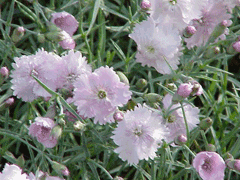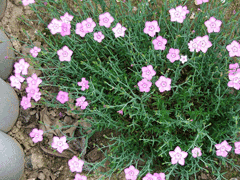 |
|
http://www.biolib.de/ |
 |
| http://commons.wikimedia.org/wiki/User:Selso |
Translate this page:
Summary
Physical Characteristics

 Dianthus gratianopolitanus is a PERENNIAL growing to 0.3 m (1ft) by 0.5 m (1ft 8in).
Dianthus gratianopolitanus is a PERENNIAL growing to 0.3 m (1ft) by 0.5 m (1ft 8in).
See above for USDA hardiness. It is hardy to UK zone 3 and is not frost tender. It is in flower from May to July, and the seeds ripen from July to August. The species is hermaphrodite (has both male and female organs) and is pollinated by Bees, Lepidoptera (Moths & Butterflies). The plant is self-fertile.
It is noted for attracting wildlife.
Suitable for: light (sandy), medium (loamy) and heavy (clay) soils and prefers well-drained soil. Suitable pH: neutral and basic (mildly alkaline) soils. It cannot grow in the shade. It prefers dry soil.
UK Hardiness Map
US Hardiness Map
Synonyms
D. caesius. D. caespitosus. D. glaucus. non L.
Plant Habitats
Ground Cover; East Wall. In. South Wall. In. West Wall. In.
Edible Uses
References More on Edible Uses
Medicinal Uses
Plants For A Future can not take any responsibility for any adverse effects from the use of plants. Always seek advice from a professional before using a plant medicinally.
None known
References More on Medicinal Uses
The Bookshop: Edible Plant Books
Our Latest books on Perennial Plants For Food Forests and Permaculture Gardens in paperback or digital formats.

Edible Tropical Plants
Food Forest Plants for Hotter Conditions: 250+ Plants For Tropical Food Forests & Permaculture Gardens.
More

Edible Temperate Plants
Plants for Your Food Forest: 500 Plants for Temperate Food Forests & Permaculture Gardens.
More

More Books
PFAF have eight books available in paperback and digital formats. Browse the shop for more information.
Shop Now
Other Uses
Can be used as a ground cover plant in a sunny position[188]. Plants should be placed about 25cm apart each way and form a slowly spreading carpet of growth[208].
Special Uses
Attracts Wildlife Ground cover Scented Plants
References More on Other Uses
Cultivation details
Prefers a dry calcareous soil and a sunny position[111]. Dislikes shade[208]. Plants succeed when grown on the top of a broad or retaining wall[219]. Plants grow well in a maritime environment, though they dislike damp conditions. Plants are hardy to about -20°c[187]. A very ornamental plant[1]. The flowers are strongly clove-scented and are very attractive to butterflies and moths[17]. The double-flowered form, 'Flore Plena' has an even stronger scent.
References Carbon Farming Information and Carbon Sequestration Information
Temperature Converter
Type a value in the Celsius field to convert the value to Fahrenheit:
Fahrenheit:
The PFAF Bookshop
Plants For A Future have a number of books available in paperback and digital form. Book titles include Edible Plants, Edible Perennials, Edible Trees,Edible Shrubs, Woodland Gardening, and Temperate Food Forest Plants. Our new book is Food Forest Plants For Hotter Conditions (Tropical and Sub-Tropical).
Shop Now
Plant Propagation
Seed - sow spring in a cold frame[111]. The seed usually germinates in 2 - 4 weeks at 20°c. When they are large enough to handle, prick the seedlings out into individual pots and grow them on in the greenhouse for their first winter. Plant them out into their permanent positions in late spring or early summer, after the last expected frosts. Cuttings in July/August in a cold frame. Very high percentage[K]. Division in March[111]. Very easy, larger clumps can be replanted direct into their permanent positions, though it is best to pot up smaller clumps and grow them on in a cold frame until they are rooting well. Plant them out in the spring.
Other Names
If available other names are mentioned here
Native Range
EUROPE: United Kingdom (England (southwest)), Belgium, Switzerland, Czech Republic, Germany, Poland, Ukraine (west), France
Weed Potential
Right plant wrong place. We are currently updating this section.
Please note that a plant may be invasive in one area but may not in your area so it's worth checking.
Conservation Status
IUCN Red List of Threatened Plants Status :

Growth: S = slow M = medium F = fast. Soil: L = light (sandy) M = medium H = heavy (clay). pH: A = acid N = neutral B = basic (alkaline). Shade: F = full shade S = semi-shade N = no shade. Moisture: D = dry M = Moist We = wet Wa = water.
Now available:
Food Forest Plants for Mediterranean Conditions
350+ Perennial Plants For Mediterranean and Drier Food Forests and Permaculture Gardens.
[Paperback and eBook]
This is the third in Plants For A Future's series of plant guides for food forests tailored to
specific climate zones. Following volumes on temperate and tropical ecosystems, this book focuses
on species suited to Mediterranean conditions—regions with hot, dry summers and cool, wet winters,
often facing the added challenge of climate change.
Read More
Expert comment
Author
Vill.
Botanical References
17200
Links / References
For a list of references used on this page please go here
Readers comment
| Add a comment |
|
If you have important information about this plant that may help other users please add a comment or link below. Only comments or links that are felt to be directly relevant to a plant will be included. If you think a comment/link or information contained on this page is inaccurate or misleading we would welcome your feedback at [email protected]. If you have questions about a plant please use the Forum on this website as we do not have the resources to answer questions ourselves.
* Please note: the comments by website users are not necessarily those held by PFAF and may give misleading or inaccurate information.
To leave a comment please Register or login here All comments need to be approved so will not appear immediately.
|
Subject : Dianthus gratianopolitanus
|
|
|
|